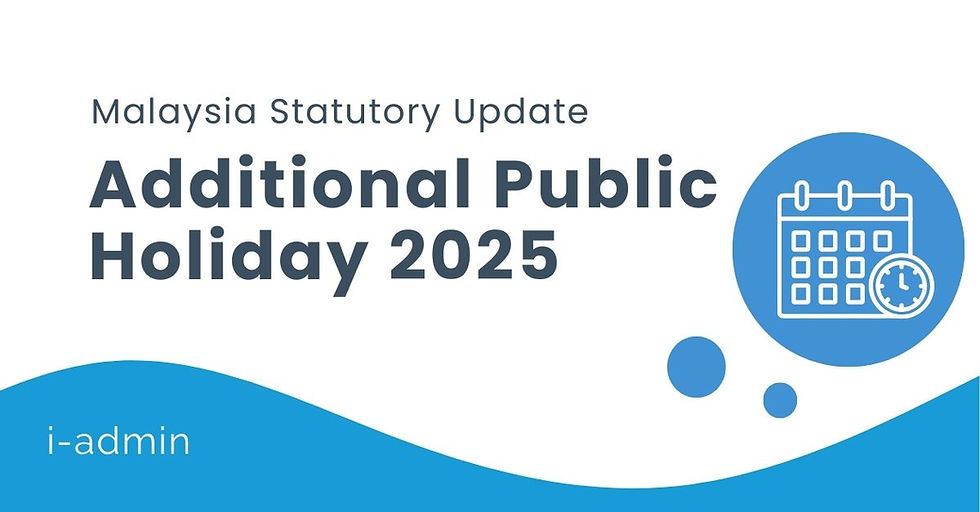A Guide for New Companies: Setting Up CPF Submission and Payment for Employee Contributions
- i-admin Singapore

- Nov 14, 2024
- 3 min read

Starting a new company is an exciting venture, but it comes with statutory responsibilities, especially when it comes to employee welfare and compliance with local regulations. One of the essential steps for newly established companies in Singapore is ensuring they are registered to manage and submit their employees' Central Provident Fund (CPF) contributions. Many new businesses are unfamiliar with the processes involved, so here’s a comprehensive guide to help you get started.
Understanding the Importance of CPF Contributions
The CPF is a mandatory social security savings scheme in Singapore that helps employees fund their retirement, healthcare, and housing needs. As an employer, contributing to your employees' CPF accounts is not just a legal obligation but a critical part of supporting your employees' long-term financial security. Failing to comply with CPF contribution requirements can lead to penalties, so it’s essential for all employers to be aware of the steps needed to ensure timely and accurate contributions.
Step 1: Applying for a CPF Submission Number (CSN)
The first step for any new company is to apply for a CPF Submission Number (CSN) from the CPF Board. This unique identifier is essential, as it enables employers to submit CPF contributions for their employees. Here’s how you can obtain a CSN:
Registering with CPF Board
Once your company is officially registered, visit the CPF Board’s official website to apply for a CPF Submission Number. Typically, you will need to provide your company’s Unique Entity Number (UEN), which is issued during business registration.
Application Process
The application can be completed online through CPF’s e-Services portal, and the process usually takes a few business days. The CSN will be sent to your company after approval, allowing you to start using the CPF e-Submit service to submit your employees' contributions.
Choosing Your Submission Method
CPF offers several ways to submit your contributions, such as through the CPF e-Submit portal or even through payroll software that integrates with CPF’s systems. Choose a submission method that suits your business size and payroll management preferences.
Step 2: Setting Up Interbank GIRO for CPF Payments
After receiving your CPF Submission Number, the next step is to apply for Interbank GIRO to facilitate the direct transfer of CPF contributions. With GIRO, you can streamline payments and ensure they’re made on time without manual intervention.
Accessing the GIRO Application Form
The GIRO application form is available on the CPF Board’s website. You will need to download and complete this form, providing essential bank account details for your company.
Submitting the Form
Submit the completed form to your bank or the CPF Board, depending on the specific instructions provided on the CPF website. Note that this process may take several weeks as it requires approval from both your bank and the CPF Board.
Confirmation of GIRO Setup
Once your GIRO application is approved, you will receive a confirmation notification from the CPF Board. This allows you to proceed with scheduled CPF payments, which will be automatically deducted from your bank account. Using GIRO helps avoid late payments and ensures compliance with CPF payment deadlines.
Key Deadlines and Compliance
To avoid penalties, companies must submit and pay their CPF contributions by the 14th of each month. Contributions that are submitted late are subject to a late payment interest rate, which can add up quickly and strain a new company’s finances. Here are a few additional compliance tips:
Regular Reconciliation: Regularly review payroll records and CPF submissions to avoid discrepancies or missed contributions.
Maintain Records: Keep detailed records of all CPF submissions and payments for future reference, especially during audits.
Stay Updated on Changes: CPF policies and contribution rates may change, so it’s essential to stay informed and make necessary adjustments.
Additional Support from CPF Board
If you have questions or need assistance during the application process, the CPF Board provides resources and customer support to guide new employers. Additionally, many payroll software providers in Singapore offer integration with CPF Board systems, simplifying compliance.
Conclusion
Establishing a new company involves multiple statutory obligations, and fulfilling CPF requirements is one of the most critical. By applying for your CPF Submission Number and setting up GIRO for CPF payments, you can streamline the process and stay compliant. Taking these steps not only safeguards your company against penalties but also builds trust with your employees by securing their CPF contributions reliably.
If you need looking a Singapore payroll solution, contact us today.





Comments